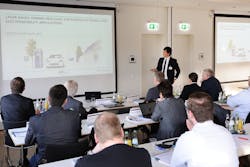Fraunhofer ILT to host laser symposium on e-mobility in 2020
2020 will be a defining year for electromobility (e-mobility) in the global vehicle industry, as it is when the EU’s binding fleet-wide CO2 emission targets come into effect. Therefore, the Second Laser Symposium on Electromobility (LSE ’20) that will take place at the Fraunhofer Institute for Laser Technology (Fraunhofer ILT; Aachen, Germany) on February 12-13, 2020, becomes a ‘must-attend’ event. The symposium will also offer a laboratory tour at Fraunhofer ILT on February 12th.
After an exclusive look at current research projects, there will be 16 talks on, for example, laser processes in battery production, laser sources in e-mobility, and production systems in laser material processing. The talks will also shed light on process monitoring, laser manufacturing methods, and laser-based treatment and processing of solid-state batteries.
Fraunhofer ILT will present a variety of battery designs and explain how they were engineered for optimum joining. To increase the charging current in the modules, cross-sections of the contacts to be welded must be sized accordingly, leading to a trend toward larger connector sizes. Because there will be some automotive manufacturers attending, there will also be a discussion regarding process monitoring in the production of battery modules.Manufacturers’ plans to start high-volume production of electric vehicles means that battery production needs to be sped up. That’s what the research project "High-throughput methods in manufacturing of lithium-ion batteries" aims towards, with a goal to create an automated, fixed-path production line that reduces cycle times by a factor of 10 by linking the assembly, stacking, and bonding processes. This would bring them to under 100 ms per assembled and stacked electrode, boosting productivity and lowering costs.
Another important topic is the blue diode laser, which has an absorption rate of more than 50% in copper alloys, making it more suitable than infrared lasers for joining electrically and thermally conductive contacts—a technology that will pave the way for new applications.
For more information, please visit http://s.fhg.de/MrA.
Source: Fraunhofer ILT press release
Got laser processing-related news to share with us? Contact David Belforte, Editor in Chief, Industrial Laser Solutions
Get even more news like this delivered right to your inbox

David Belforte | Contributing Editor
David Belforte (1932-2023) was an internationally recognized authority on industrial laser materials processing and had been actively involved in this technology for more than 50 years. His consulting business, Belforte Associates, served clients interested in advanced manufacturing applications. David held degrees in Chemistry and Production Technology from Northeastern University (Boston, MA). As a researcher, he conducted basic studies in material synthesis for high-temperature applications and held increasingly important positions with companies involved with high-technology materials processing. He co-founded a company that introduced several firsts in advanced welding technology and equipment. David's career in lasers started with the commercialization of the first industrial solid-state laser and a compact CO2 laser for sheet-metal cutting. For several years, he led the development of very high power CO2 lasers for welding and surface treating applications. In addition to consulting, David was the Founder and Editor-in-Chief of Industrial Laser Solutions magazine (1986-2022) and contributed to other laser publications, including Laser Focus World. He retired from Laser Focus World in late June 2022.

